An Entrepreneurship Venture for Training K–12 Teachers to Use Engineering as a Context for Learning
Abstract
:1. Introduction
1.1. The Need
1.2. Our Response to the Needs: A Teacher PD Program for Select School Districts in Cincinnati
- (1)
- How do students in a design and CBL environment engage in decision making, strategic planning, evaluating a revision of plans, creative thinking, and task persistence?
- (2)
- How do students in design and CBL environments perceive their involvement in STEM careers?
- (3)
- What measures and instruments are most effective at capturing and documenting these leaning tasks?
- (4)
- How are the teachers’ gains in knowledge of engineering transferred into instructional plans?
- (5)
- What supports and barriers do teachers encounter as they implement their plans with students?
- (6)
- How do the knowledge gains and implementation factors impact the teachers’ pedagogical content knowledge?
- Student knowledge gains were higher: 8.5% higher on the post-test versus comparison teachers’ students, which is statistically significant at a 95% confidence interval.
- Engineering design practice requires that students use high-level cognitive demand, which involves making connections while solving problems: 89% of students (more than 18,000 participated) reported successfully understanding and implementing the EDP to seek and defend an optimum solution to a real-world problem with constraints.
- Integration of CBL and EDP instructional practices ensured usage of a wider variety of active learning strategies: Classroom Observation and Analytic Protocol [56] data showed that CEEMS teachers used probative, open-ended questioning that encouraged critical thinking, as well as the EDP and CBL strategies, collaborative grouping, and use of external resources (e.g., videos) as a means to focus the lesson on real-world issues.
- Student engagement and buy-in was ensured: In post-teaching surveys, teachers reported (100% strongly agreed or agreed) that they saw increased classroom engagement compared to when non-CEEMS units were taught.
- Teachers saw the benefit of continued use of CEEMS teaching pedagogies (CBL and the EDP) with time: Teachers’ current instructional practices (CIP) surveys indicated a significant increase of their usage of these teaching pedagogies during the project (from pre-project to one year, and pre- to post-project/two years) and one year after programming ended.
- Over time teachers learned to negotiate successfully through barriers and lack of supports reported for student-centered reforms, and to minimize their impact.
1.3. Taking CEEMS beyond Its Partnership
2. Research Methods
2.1. Initial Training
- (1)
- Determine the readiness of their educational innovation for sustainable scalability as a self-supported entity that is able to systematically promote its adoption and enable and facilitate its use;
- (2)
- Enable the team to develop a clear go/no-go decision regarding sustainable scalability of the educational innovation;
- (3)
- Help develop a transition plan and actionable tasks to move the educational innovation forward to sustainable scalability, if the team decides to do so.
- (1)
- teams were introduced to the Lean Launchpad approach;
- (2)
- teams learned the business model development and customer development process;
- (3)
- teams met with customers (a minimum of 25) and presented what they learned to the class.
2.2. Our Development Process
2.3. Customer Research
- (1)
- science and math K–12 teachers will value the CEEMS [44] model;
- (2)
- there are relatively few alternatives;
- (3)
- we can develop a scalable CEEMS model that retains value.
Furthermore, key insights were developed as they related to our hypotheses. These concise summaries were an excellent way for us manage the large amount of information we collected from our 100+ interviews. As an example, the key insight we developed for the above interview was:Interviewee: STEM Facilitator, school in Oklahoma“Oklahoma has its own science standards which are similar to NGSS minus evolution and climate change. Interviewee used to be science curriculum coordinator before he took on current position. Involved in [a state of Oklahoma funded] MSP (Math & Science Partnership) program where teachers invest two weeks in PD-half of PD involves pedagogy and half of time they are working with OU researcher on actual research. Believes meaningful PD cannot be shorter than two weeks. Waiting list for MSP PD as it is very popular. His MSP does struggle with Saturday follow up only 1/3 show up; teachers have family priorities on Saturdays. Measurement tools for own MSP mostly focuses on teacher change; has some data related to student performance but that is hard to quantify. Some teachers going through MSP then were motivated to seek advanced degrees. In their district most science teachers have less than five years of experience; many have science minors rather than science majors and therefore are lacking in content. As soon as teachers achieve a paradigm shift and get it, they leave district or become consultants. Teacher PD needs to focus on how science works, what science is, and how to integrate science practices. There is no $ in Oklahoma district budgets for outside PD in science and social studies. All PD funds are directed to English/LA and math. All science PD must occur at district level; best is informal in nature when conversations occur about curriculum. Teachers are required to do 15 h of PD per year and can easily get that by coming to district sponsored PD; some PD offered at district is not science specific.”
“No money in Oklahoma districts for outside PD in science or social studies; all science PD must be homegrown due to lack of funds or rely on grant funding. Does not think PD experience will be meaningful if it is less than two weeks; measuring teacher change may be enough to prove effectiveness.”
2.4. Our Value Proposition
2.5. Establishing Customer Types and Needs
2.6. Marketing Channels
“I am more motivated to work hard if I have to physically go somewhere.”“If the PD or course was online, I would likely procrastinate.”“I have three kids and feel I would need to physically get out of the house in order to get work done.”“I enjoy the interpersonal interaction that accompanies face to face PD.”“Online programs are often ‘flat’ and not inspiring.”
2.7. Customer Relationships
“Having access to coaches and other teachers is important as it helps gain confidence in using CBL and EDP.”“Collaboration with other life science teachers is very important.”“I am open to the online channel but believe that meeting fact to face with other teachers in her district would be beneficial. I do not think that this model will work well if a teacher signs up by themselves.”
2.8. Revenue Streams
2.9. Key Resources
2.10. Key Activities
2.11. Key Partnerships
ENGR 7050: Engineering Education Certificate Capstone (3 credits) (University of Cincinnati, 2018): This capstone course provides a structured and supported process for certificate participants to implement what they have learned through certificate courses. Participants will be required to develop and implement one full curricular unit of instruction that utilizes engineering design-based challenges within a course that they teach. Participants will have a mentor to guide them through this process. Completed activities and units are to be written using a common framework and published to an open education resource so other teachers can use them. The course is configured to be taken by a teacher after completing the required course, Engineering Foundations, during a semester when the teacher could teach the unit in a class while simultaneously taking the course.
2.12. Cost Structure
2.13. Insights from Our Customer Research
- Teachers often found that professional development programs were of no value to them if they could not take what they’d learned back to the classroom and implement it. It is important therefore that new knowledge be easily implementable when teachers finish with the professional development program.
- The ability to collaborate with fellow teachers is necessary to enable them to discuss new lesson ideas, reinforce their knowledge of the new pedagogy, and permit them to discuss best classroom practices.
- Coaching was a very popular concept that most believed would enable them to become more adept at using the CBL pedagogy.
- Creating their own lessons was not only an important concept to the teachers, but to administrators as well, as it provided more flexibility to create lesson plans that are tailored to student needs.
- Classroom practices that stimulate student engagement were identified as necessary.
- A reasonable cost (~$250 for PD) was identified as necessary.
2.14. Final Business Model Canvas and Customer and Revenue Flow
3. Results
3.1. The Creation of an Online Professional Development Program with Virtual Coaching: The MVP
3.2. Branding the MVP
- (1)
- It must be consistent with mission and vision, which were fixed as follows:
- ○
- Mission: Our program is a teacher-recommended, online professional development program that helps teachers meet new science/mathematics and engineering practice standards.
- ○
- Vision: Created to help teachers transform their classrooms into student-centered, hands-on learning environments.
- (2)
- It must clearly communicate the provided services (what it is). We selected the brand name as STEMucation Academy, which combined the words “STEM” (science, technology, engineering, and mathematics) and “education” to convey the message the program offers professional development training in “STEM education”. The official trademark for the name was obtained by the University of Cincinnati Research Institute (UCRI), an Ohio non-profit corporation affiliated with UC. The domain name stemucationacademy.org and stemucationacademy.com were also purchased for web development and email usage, respectively.
- (3)
- It must demonstrate the benefits of our service—assisting teachers to improve their evaluation scores related to science, mathematics, and engineering instruction.
- (4)
- It has meaning to target audiences. The STEMucation Academy brand is one that generates feelings of confidence, approachability, collaboration, and individualization.
- (5)
- It must be distinguishable from other PD organizations in that it facilitates the development of new units as needed to meet individual curriculum and student needs, and be guided and vetted by professional coaches.
3.3. Testing Our Model
- We were able to implement an engineering design activity to simulate a classroom challenge
- Participants were able to work on their own unit of instruction and presented their plans
- We received first-hand feedback from the ultimate users on what our planned online PD program or workshops should make clear:
- ○
- What does it look like to teach STEM by integrating engineering into one’s classroom?
- ○
- How can and does science and math education benefit from including the EDP?
3.4. Creating the Marketing Website
3.5. Alpha Testing: Piloting the Online PD Program
- -
- “I liked that I could go at my own pace, look ahead to all of the modules so I could get the whole picture before actually doing each module, and I liked that there was someone I could contact to bounce ideas off.”
- -
- “The self-pace was great!”
- -
- “I liked how I could go back and re-watch something to help me understand.”
- -
- “The resources were great.”
- -
- “My coach was great! She was very helpful and supportive.”
- -
- “I had an awesome coach who I enjoyed working with. She was always giving me ideas and helped me in any way.”
- -
- “I liked the timeline of the workshop. Having due dates for parts of the STEM unit was helpful. Working with a mentor was also helpful.”
- (1)
- they felt much more comfortable and competent in their ability to create and teach a unit incorporating an engineering design challenge;
- (2)
- the coach was great and was the key support to their success in completing the online PD course;
- (3)
- the breakdown of modules into engineering process steps was helpful in learning about the EDP.
- Fluency in Using Blackboard: CourseSites by Blackboard was used to offer the STEMucation Academy’s online PD program for both pilots. A debrief with the coaches was held after each pilot. Generally, the feedback received from the coaches was positive. All coaches felt that even though CourseSites was an appropriate platform for the online PD program, they reported that a few student teachers initially had challenges navigating CourseSites. Overall coaches felt the student teachers were capable of mastering all subject areas, were communicative, and put forth an above-average amount of effort to master the techniques being taught in the online PD program.Due to the issues arising from the use of CourseSites, an alternative learning management system was sought. As most coaches and participants are familiar with cloud-based products such as Google Drive, YouTube, and Microsoft Office products such as Word and PowerPoint, a decision was made to convert the online program materials to a format that allowed the participants and coaches to get "up and running" more quickly. This also permitted modifications to the online program to be made by personnel not experienced in the use of CourseSites.A study guide was created for each of the eight STEMucation Academy modules. These study guides are in PDF format, which is universally readable on all types of digital devices including tablets, smartphones, and computers. The study guides include a module overview, module objectives, assignments, and other instructions to help the participant navigate the course. Hyperlinks to videos and other course supplements are imbedded in the modules. At the time of writing this paper, the new format has been evaluated and is being used by teachers currently enrolled in the STEMucation Academy’s online PD course.
- Need for Better Management of the Discussion Board: Some participants expressed a need for better management of the discussion board to ensure timely interactions with the coaches and on-time completion of the modules. Based on this feedback and the fact that the course participants did not always participate in one-on-one discussions with their coach, the discussion board was dropped and the one-on-one meetings between participant and coach became mandatory. This alternate form of communication allows the coach to better assess the participants’ progress and, if needed, offer mid-course corrections.
- Issues with Purpose and Submission of Rubrics. We found participants wanted more explanation of the course requirements and the rubric elements used to assign a grade. Having a clear definition of expected performance would help the participant understand what their work product should focus on. Each of the eight modules contain a number of assignments and each assignment has one or more rubric elements associated with it. Overall there are more than 20 rubric elements distributed over the eight modules. A sample rubric element is illustrated in Table 6.
3.6. Moving Forward: Licensing Out the Program for Marketing
3.7. Ongoing Efforts for Broader Impacts
- Engineering Foundations
- Engineering Education Certificate Capstone
- Models and Applications of Physical Sciences
- Engineering Applications in Math—this contains two sections, one for high-school teachers and the other for middle-school teachers (it could also be taken by elementary school teachers)
- Engineering Models
4. Concluding Remarks
- include online and face-to-face channels of service (make both options available);
- make it self-paced and flexible to fit the teacher’s curricular needs and teaching schedule;
- condense it for successful completion within a semester (≤16 weeks);
- include virtual coaching to assist teachers in producing the curriculum, teaching it, assessing student learning gains, reflecting after teaching, and documenting for web dissemination to other teachers for quality assurance, guidance, and approval;
- ensure costs are fixed at a level that can be paid either by a teacher or by the school district.
Author Contributions
Funding
Acknowledgments
Conflicts of Interest
References
- Anderson, K.J.B. Science Education and Test-Based Accountability: Reviewing their Relationship and Exploring Implications for Future Policy. Sci. Educ. 2012, 96, 104–129. [Google Scholar] [CrossRef]
- NGSS Lead States. Next Generation Science Standards: For States, by States; The National Academies Press: Washington, DC, USA, 2013; ISBN 978-0-309-27227-8. [Google Scholar]
- Common Core State Standards Initiative (CCSSI). Common Core State Standards for Mathematics; National Governors Association Center for Best Practices and the Council of Chief State School Officers: Washington, DC, USA, 2010; Available online: http://www.corestandards.org/Math/Practice/ (accessed on 9 March 2019).
- National Academy of Science, National Academy of Engineering and National Research Council. Engineering in K–12 Education: Understanding the Status and Improving the Prospects 2009; The National Academies Press: Washington, DC, USA, 2009. [Google Scholar] [CrossRef]
- Griffard, P.B.; Wandersee, J.H. Challenges to Meaningful Learning Among African-American Females at an Urban Science High School. Int. J. Sci. Educ. 1999, 21, 611–632. [Google Scholar] [CrossRef]
- Loucks-Horsley, S.; Hewson, P.W.; Love, N.; Stiles, K.E. Designing Professional Development for Teachers of Science and Mathematics; Corwin Press: Thousand Oaks, CA, USA, 1998; ISBN 978-1-4129-6360-2. [Google Scholar]
- Teel, K.M.; Debruin-Parecki, A.; Covington, M.V. Teaching Strategies That Honor and Motivate Inner-city African–American Students: A School/University Collaboration. Teach. Teach. Educ. 1998, 14, 479–495. [Google Scholar] [CrossRef]
- Mayer, R.E. Invited Reaction: Cultivating Problem-Solving Skills Through Problem-Based Approaches to Professional Development. Hum. Resour. Dev. Q. 2002, 13, 263–269. [Google Scholar] [CrossRef]
- Hashweh, M.Z. Effects of Subject Matter Knowledge in the Teaching of Biology and Physics. Teach. Teach. Educ. 1987, 3, 109–120. [Google Scholar] [CrossRef]
- Furguson, R. Paying for Public Education: New Evidence on How and Why Money Matters. Harv. J. Legis. 1991, 28, 465–498. [Google Scholar]
- Kennedy, M.M. Education Reform and Subject Matter Knowledge. Res. Sci. Teach. 1998, 35, 249–263. [Google Scholar] [CrossRef]
- Cohen, D.; Hill, H. Instructional Policy and Classroom Performance: The Mathematics Reform in California. Teach. Coll. Rec. 2000, 102, 294–343. Available online: http://www-personal.umich.edu/~dkcohen/cohen_hill_2000_TCR.pdf (accessed on 9 March 2019). [CrossRef]
- Muijs, D.; Reynolds, D. School Effectiveness and Teacher Effectiveness in Mathematics: Some Preliminary Findings from the Evaluation of the Mathematics Enhancement Program (Primary). Sch. Eff. Sch. Improv. 2000, 11, 273–303. [Google Scholar] [CrossRef]
- Cohen, D.K.; Hill, H.C. State Policy and Classroom Performance: Mathematics Reform in California (CPRE Policy Brief); Consortium for Policy Research in Education: Philadelphia, PA, USA, 1998. [Google Scholar]
- Kahle, J.B.; Meece, J.; Scantlebury, K. Urban African-American Middle School Science Students: Does Standards-Based Teaching Make a Difference? Res. Sci. Teach. 2000, 37, 1019–1041. [Google Scholar] [CrossRef]
- Klein, S.P.; Hamilton, L.S.; McCaffrey, D.F.; Stecher, B.M.; Robyn, A.; Burroughs, D. Teaching Practices and Student Achievement: Report of First-Year Findings from the ‘Mosaic’ Study of Systemic Initiatives in Mathematics and Science; RAND Corporation: Santa Monica, CA, USA, 2000; Available online: https://www.rand.org/pubs/monograph_reports/MR1233.html (accessed on 31 October 2018).
- Weiss, I.R.; Montgomery, D.L.; Ridgway, C.J.; Bond, S.L. Local Systemic Change through Teacher Enhancement: Year Three Cross-Site Report; Horizon Research Inc.: Chapel Hill, NC, USA, 1998; Available online: http://www.horizon-research.com/local-systemic-change-through-teacher-enhancement-year-three-cross-site-report (accessed on 31 October 2018).
- National Commission on Math and Science Education for the 21st Century; Glenn. Before It’s Too Late: A Report to the Nation from the National Commission on Mathematics and Science Teaching for the 21st Century; Department of Education: Washington, DC, USA, 2000.
- Lieberman, A.; Grolnick, M. Networks and Reform in American Education. Teach. Coll. Rec. 1996, 98, 36–40. [Google Scholar]
- Sparks, D. Focusing Staff Development on Improving Student Learning. In Handbook of Research on Improving Student Achievement; Cawelti, G., Ed.; Educational Research Service: Arlington, VA, USA, 1995; pp. 163–169. ISBN 10 1931762295. [Google Scholar]
- Little, J.W. Teachers’ Professional Development in a Climate of Educational Reform. Educ. Eval. Policy Anal. 1993, 15, 129–151. [Google Scholar]
- Gamoran, A.; Secada, W.G.; Marrett, C.B. The Organizational Context of Teaching and Learning. In Handbook of the Sociology of Education; Hallinan, M.T., Ed.; Springer: New York City, NY, USA, 2000; ISBN 978-0-387-36424-7. [Google Scholar]
- American Association for the Advancement of Science. Atlas of Science Literacy: Project 2061; AAAS: Washington, DC, USA, 2007; Chapter 3; ISBN 978-0871686688. [Google Scholar]
- Putnam, R.; Borko, H. What Do New Views of Knowledge and Thinking Have to Say About Research on Teacher Learning? Educ. Res. 2000, 29, 4–15. [Google Scholar] [CrossRef]
- Rutherford, F.J.; Ahlgren, A. Science for All Americans; Oxford University Press: New York City, NY, USA, 1990; ISBN 0-19-506770-3. [Google Scholar]
- Morrison, J.S. TIES STEM Education Monograph Series: Attributes of STEM Education; Teaching Institute for Essential Science: Cleveland, OH, USA, 2006. [Google Scholar]
- Meeth, L. Interdisciplinary Studies: A Matter of Definition. Chang. Mag. High. Learn. Routl. 1978, 10, 10. [Google Scholar] [CrossRef]
- Committee on Science Learning K-8. Taking Science to School; The National Academies Press: Washington, DC, USA, 2007; ISBN 0-309-10205-7. [Google Scholar]
- National Research Council. Inquiry and the National Science Education Standards: A Guide for Teaching and Learning; The National Academies Press: Washington, DC, USA, 2000; ISBN 0-309-06476-7. [Google Scholar]
- Benenson, G. The Unrealized Potential of Everyday Technology as a Context for Learning. Res. Sci. Teach. 2001, 38, 730–745. [Google Scholar] [CrossRef]
- Crismond, D. Learning and Using Science Ideas When Doing Investigate-and-Redesign Tasks: A Study of Naive, Novice, and Expert Designers Doing Constrained and Scaffolded Design Work. Res. Sci. Teach. 2001, 38, 791–820. [Google Scholar] [CrossRef]
- Kolodner, J.L. Facilitating the Learning of Design Practices: Lessons Learned from Inquiry into Science Education. J. Ind. Teach. Educ. 2002, 39, 9–40. [Google Scholar]
- Mehalik, M.M.; Doppelt, Y.; Schunn, C.D. Middle-School Science Through Design-Based Learning Versus Scripted Inquiry: Better Overall Science Concept Learning and Equity Gap Reduction. J. Eng. Educ. 2008, 97, 71–85. [Google Scholar] [CrossRef]
- Greenwald, N.L. Learning from Problems. Sci. Teach. 2000, 67, 28–32. [Google Scholar]
- Snetsinger, C.; Brewer, C.; Brown, F. Capture the Wind. Sci. Teach. 1999, 66, 38–42. [Google Scholar]
- Lewis, T. Design and Inquiry: Bases for an Accommodation between Science and Technology Education in the Curriculum? Res. Sci. Teach. 2006, 43, 255–281. [Google Scholar] [CrossRef]
- Schwartz, D.L.; Lin, X.; Brophy, S.; Bransford, J.D. Toward the Development of Flexibly Adaptive Designs. In Instructional-Design Theories and Models: A New Paradigm of Instructional Theory; Reigeluth, C.M., Ed.; Lawrence Erlbaum Associates: Mahwah, NJ, USA, 1999; Volume II, pp. 183–213. [Google Scholar]
- Klein, S.S.; Sherwood, R. Exemplary Science in Grades 9-12—Standards Based Success Stories; NSTA Press: Arlington, VA, USA, 2005; pp. 43–50. ISBN 0-87355-257-1. [Google Scholar]
- Klein, S.S.; Sherwood, R. Biomedical Engineering and Cognitive Science as the Basis for Secondary Science Curriculum Development: A Three-Year Study. Sch. Sci. Math 2005, 105, 384–401. [Google Scholar] [CrossRef]
- Klein, S.S.; Harris, A.H. A User’s Guide for the Legacy Cycle. Educ. Hum. Dev. 2007, 1, 1–16. [Google Scholar]
- Brophy, S.B.; Klein, S.S.; Portsmore, M.; Rogers, C. Advancing Engineering Education in P-12 Classrooms. J. Eng. Educ. 2008, 97, 369–387. [Google Scholar] [CrossRef]
- Corday, D.S.; Harris, T.R.; Klein, S.S. A Research Synthesis of the Effectiveness, Replicability, and Generality of the VaNTH Challenge-based Instructional Modules in Bioengineering. J. Eng. Educ. 2009, 98, 335–348. [Google Scholar] [CrossRef]
- Walker, A.E.; Leary, H.; Hmelo-Silver, C.E.; Ertmer, P.A. (Eds.) Essential Readings in Problem Based Learning: Exploring and Extending the Legacy of Howard S. Barrows; Purdue University Press: West Lafayette, IN, USA, 2015; ISBN 9781612493688. [Google Scholar]
- The Cincinnati Engineering Enhanced Math and Science Program (CEEMS). Available online: https://ceas.uc.edu/special_programs/ceems/CEEMS_Home.html (accessed on 31 October 2018).
- Ohio Department of Education. Ohio Learning Standards. Available online: http://education.ohio.gov/Topics/Learning-in-Ohio/OLS-Graphic-Sections/Learning-Standards (accessed on 31 October 2018).
- Steimle, J.; Kukreti, A.R.; Maltbie, C.V. Best Practice for Incorporating STEM into Rural Schools: Train and Invest in Teacher Leaders. In Proceedings of the ASEE Annual Conference and Exposition, New Orleans, LA, USA, 26–29 June 2016. [Google Scholar]
- Kukreti, A.R.; Steimle, J. Coaching: Key to Success of Middle School/High School STEM Program. In Proceedings of the Mentoring Conference, Albuquerque, NM, USA, 25–28 October 2016. [Google Scholar]
- Steimle, J.; Kukreti, A.R.; Meyer, H. Evaluating the Risk: In an Age of High Stakes Testing, Should Teachers Integrate Engineering Design into Traditional Science and Math Courses? In Proceedings of the ASEE Annual Conference & Exposition, Columbus, OH, USA, 25–28 June 2017. [Google Scholar]
- Meyer, H. Integrating Engineering into an Urban Science Classroom. Urban Learn. Teach. Res. 2017, 13, 112–123. [Google Scholar]
- Meyer, H. Teachers’ Thoughts on Student Decision Making during Engineering Design Lessons. Educ. Sci. 2018, 8, 9. [Google Scholar] [CrossRef]
- Kukreti, A.R.; Meyer, H.; Steimle, J.; Liberi, D. Energize Your Classroom with Engineering Design Challenges: Science and Math Teachers Share Their Experiences; NSTA Press: Arlington, VA, USA, in press; ISBN 978-1-68140-698-5.
- Apple Inc. Challenge Based Learning. 2010. Available online: http://apple.co/2iAn4Wk (accessed on 31 October 2018).
- Morrison, A.B.; Maltbie, C.V.; Short, A.D.; Wiechman, S.; Tellmann, J.; Swonger, G.; Dariotis, J.K. Key Evaluation Results of the CEEMS Project, Year 7; Evaluation Services Center, University of Cincinnati: Cincinnati, OH, USA, 2018; Available online: http://bit.ly/2017-2018-CEEMS-ESC-Final-Report (accessed on 31 October 2018).
- Dixon, M.L.; Li, Y.; Woodruff, S.B. Evaluation of CEEMS: The Cincinnati Engineering Enhanced Mathematics and Science Partnership Project: Annual report, 2017–2018; Miami University, Discovery Center for Evaluation, Research, and Professional Learning: Oxford, OH, USA, 2018; Available online: http://bit.ly/2017-2018-CEEMS-Final-Eval-Report-Miami-University (accessed on 31 October 2018).
- Meyer, H. 2017–2018 CEEMS Research Report; University of Cincinnati, College of Education, Criminal Justice and Human Services School of Education, FUSION Center: Cincinnati, OH, USA; Available online: http://bit.ly/2017-2018-CEEMS-Final-Research-Study-Report (accessed on 31 October 2018).
- Horizon Research Inc. Inside the Classroom Observation and Analytic Protocol. 2000. Available online: http://www.horizon-research.com/inside-the-classroom-observation-and-analytic-protocol (accessed on 20 October 2018).
- Boyer, E.L. Scholarship Reconsidered: Priorities of the Professoriate; Jossey-Bass: San Francisco, CA, USA, 2014. [Google Scholar]
- National Science Foundation. Shaping the Future: New Expectations for Undergraduate Education in Science, Mathematics, Engineering, and Technology; Report: NSF96139; NSF, Directorate for Education and Human Resource: Arlington, VA, USA, 1996. [Google Scholar]
- National Research Council. Transforming Undergraduate Education in Science, Mathematics, Engineering and Technology; National Academy Press: Washington, DC, USA, 1999; ISBN 0-309-06294-2. [Google Scholar]
- National Research Council. Evaluating and Improving Undergraduate Teaching in Science, Technology, Engineering and Mathematics; The National Academies Press: Washington, DC, USA, 2003. [Google Scholar] [CrossRef]
- National Research Council. Improving Undergraduate Instruction in Science, Technology, Engineering, and Mathematics: Report of a Workshop; The National Academies Press: Washington, DC, USA, 2003. [Google Scholar] [CrossRef]
- Committee on Science, Engineering, and Public Policy. Rising Above the Gathering Storm: Energizing and Employing America for a Brighter Economic Future; The National Academies Press: Washington, DC, USA, 2005; Available online: http://www.nap.edu/books/0309100399/html (accessed on 9 March 2019).
- National Academy of Engineering. Engineer of the 2020: Visions of Engineering in the New Century; The National Academies Press: Washington, DC, USA, 2005; Available online: http://www.nap.edu/books/0309091624/html (accessed on 9 March 2019).
- National Academy of Engineering. Educating the Engineer of 2020: Adapting Engineering Education to the New Century; The National Academies Press: Washington, DC, USA, 2005. [Google Scholar] [CrossRef]
- Jamieson, L.H.; Lohmann, J.R. Creating a Culture for Scholarly and Systematic Innovation in Engineering Education: Ensuring US Engineering Has the Right People with the Right Talent for a Global Society; American Society of Engineering Educators: Washington, DC, USA, 2009. [Google Scholar]
- National Academy of Sciences, National Academy of Engineering, and Institute of Medicine. Rising Above the Gathering Storm, Revisited: Rapidly Approaching Category 5; The National Academies Press: Washington, DC, USA, 2010; ISBN 978-0-309-16097-1. [Google Scholar] [CrossRef]
- Blank, S.; Dorf, B. The Startup Owner’s Manual: The Step-by-Step Guide for Building a Great Company; K&S Ranch, Inc.: Pescadero, CA, USA, 2012. [Google Scholar]
- MacNeal, R. Agile Teams and Projects. In Teamwork and Project Management (Basic Engineering Series and Tools), 4th ed.; Smith, K.A., Ed.; McGraw-Hill: New York City, NY, USA, 2014; pp. 143–153. [Google Scholar]
- Osterwalder, A.; Pigneur, Y. Business Model Generation; John Wiley and Sons Inc.: Hoboken, NJ, USA, 2010. [Google Scholar]
- Value Proposition Canvas Template. Available online: https://www.peterjthomson.com/2013/11/value-proposition-canvas/ (accessed on 31 October 2018).
- STEMucation Academy. Training Workshops and Unit of Instruction Resources for Teachers. 2018. Available online: http://stemucationacademy.com (accessed on 9 March 2019).
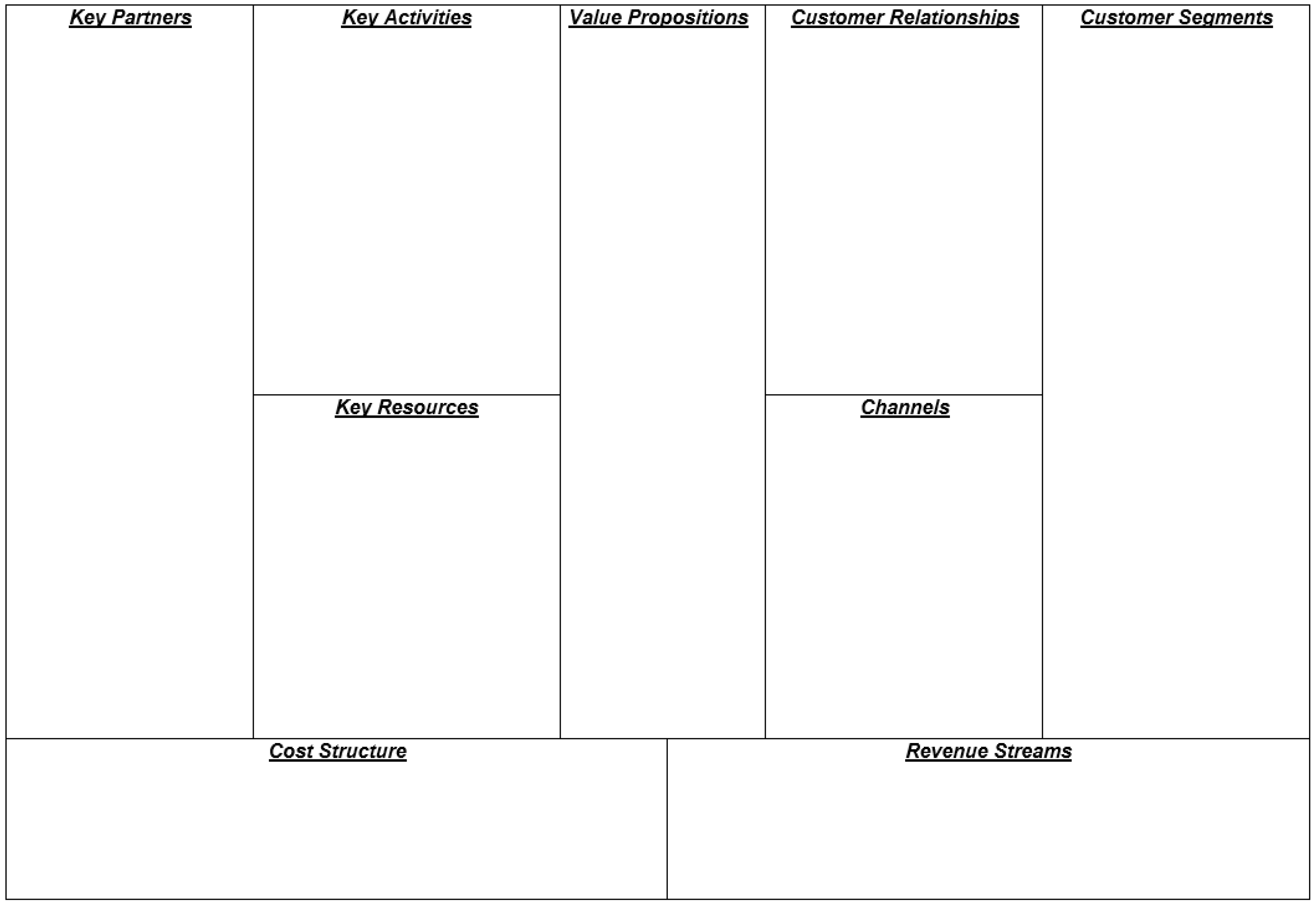

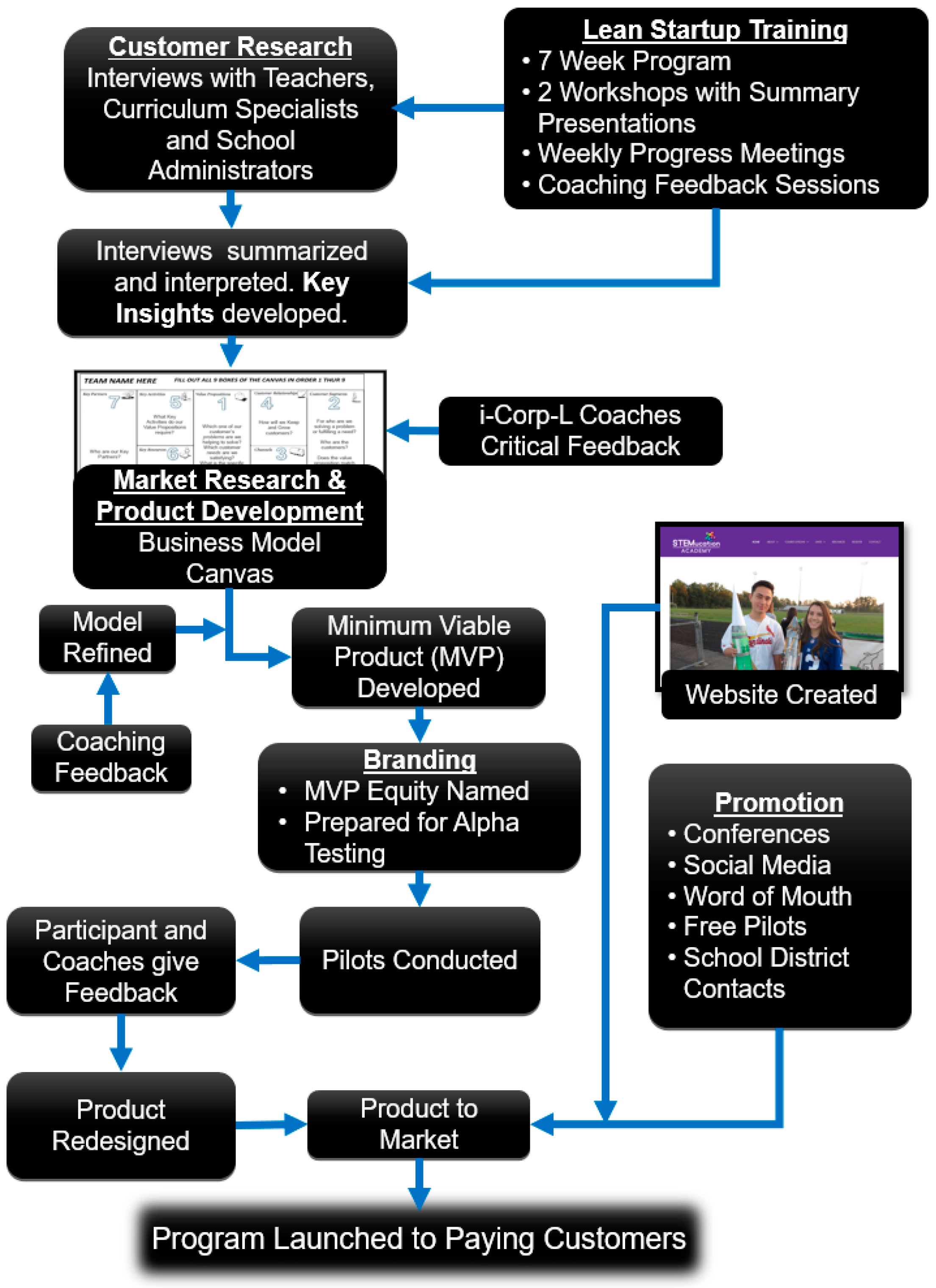
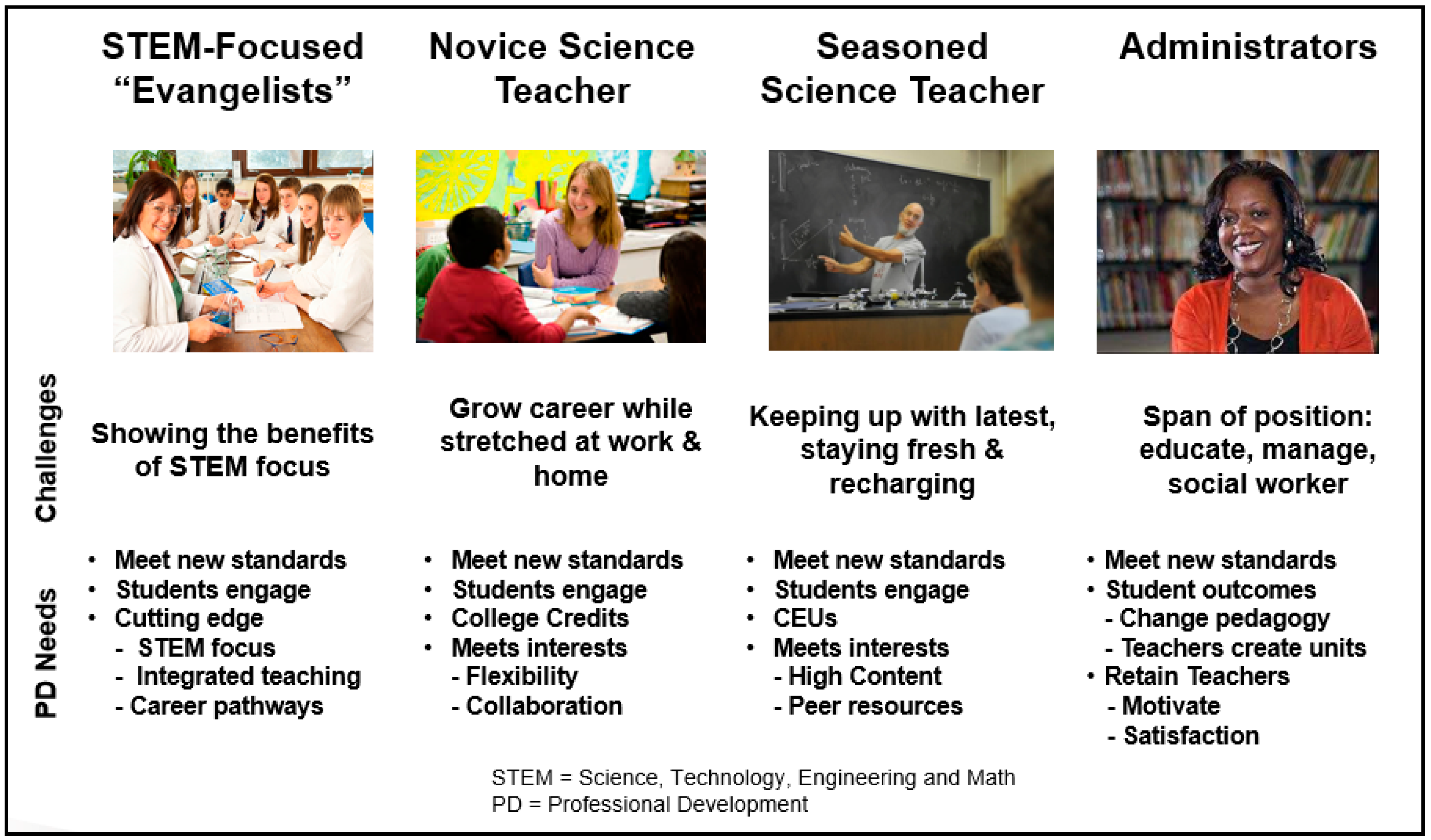
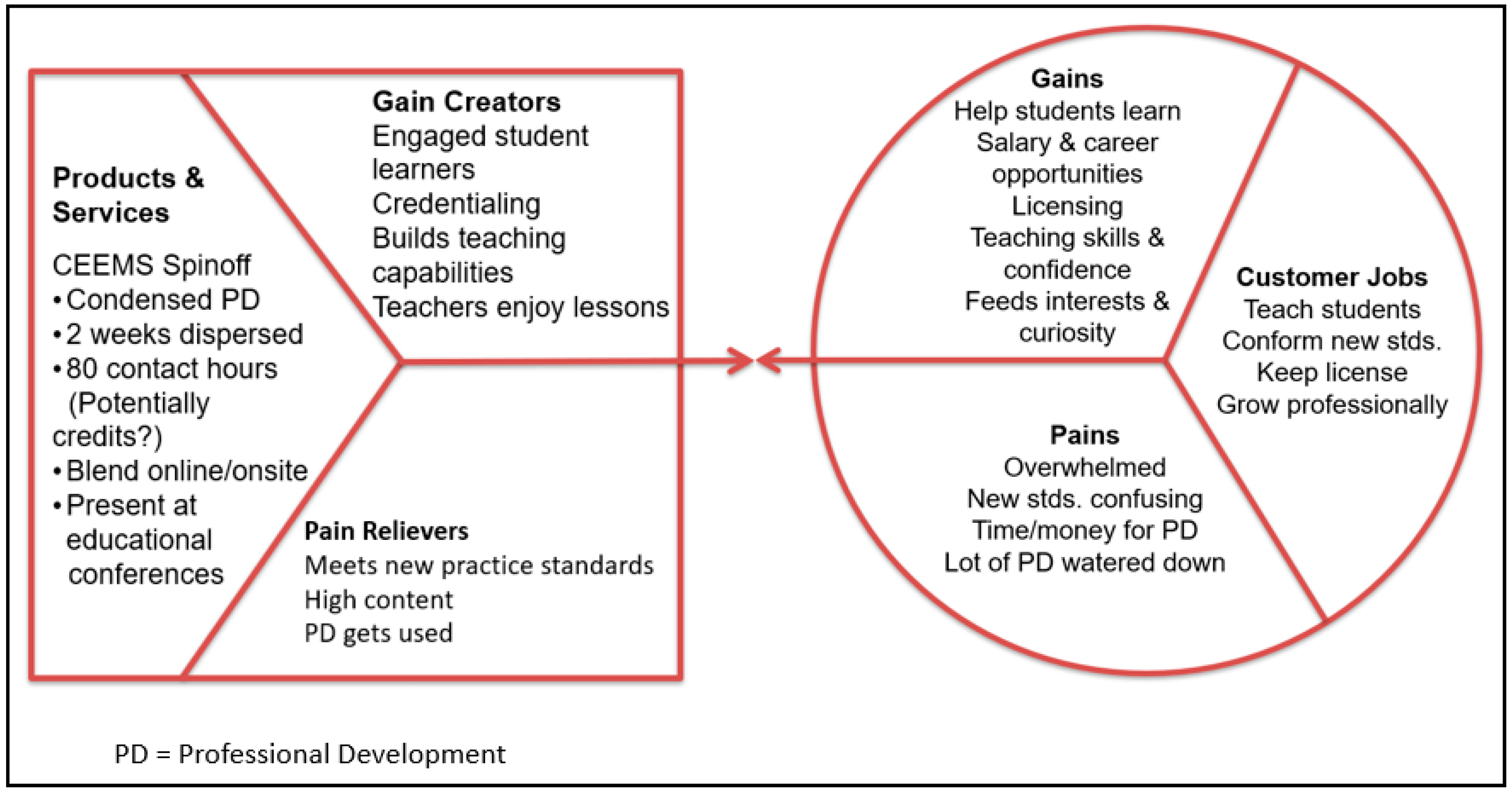

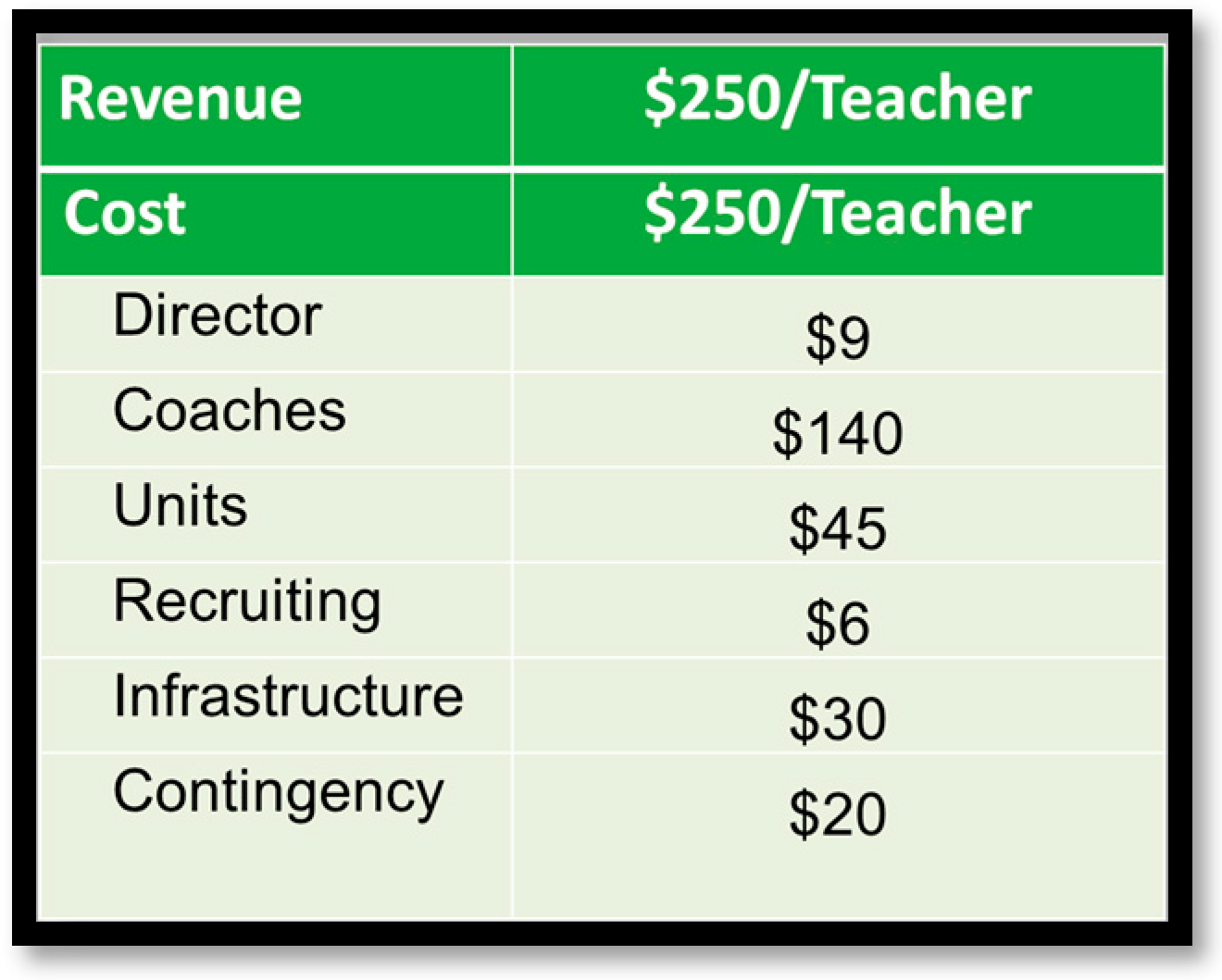
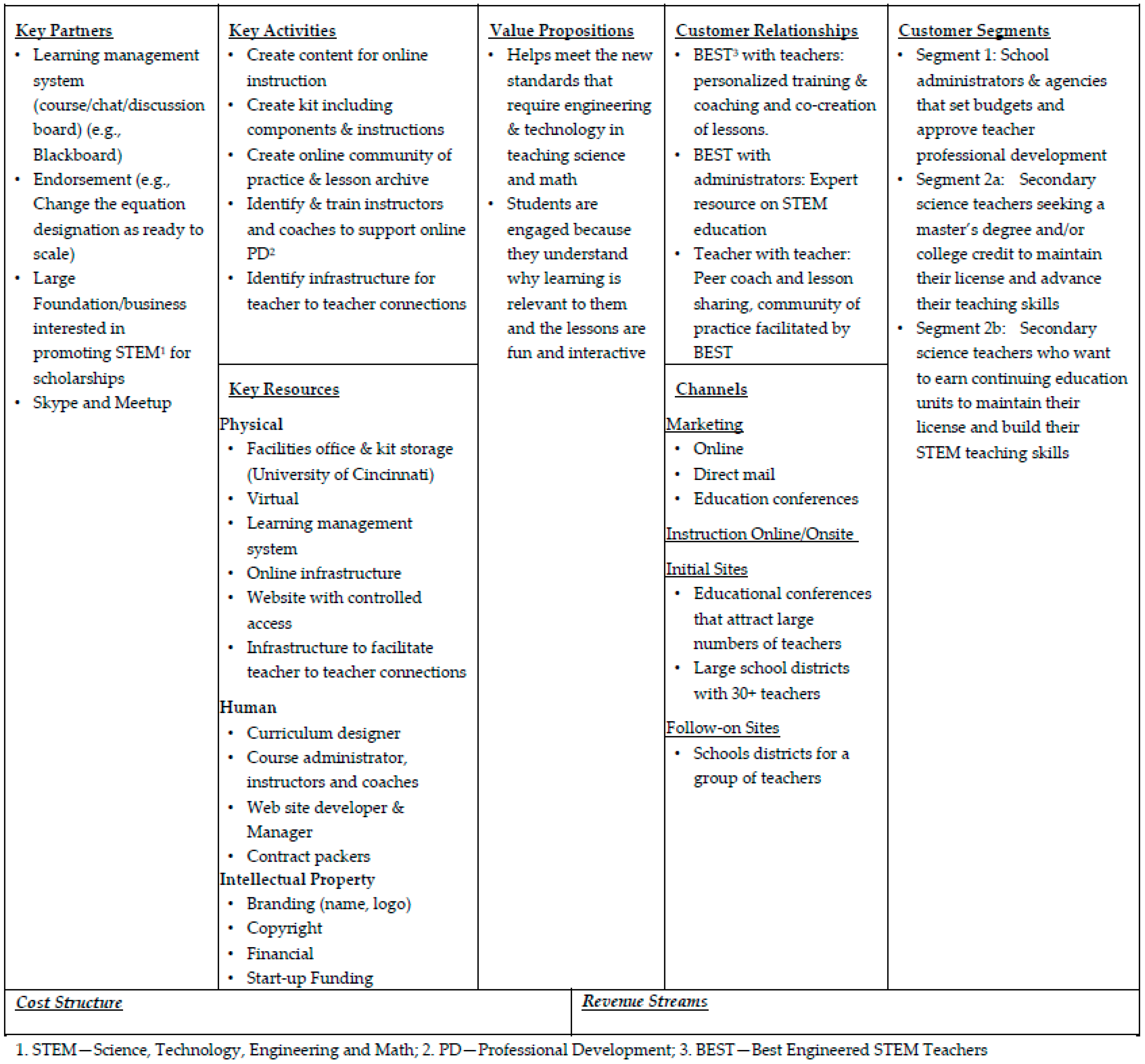
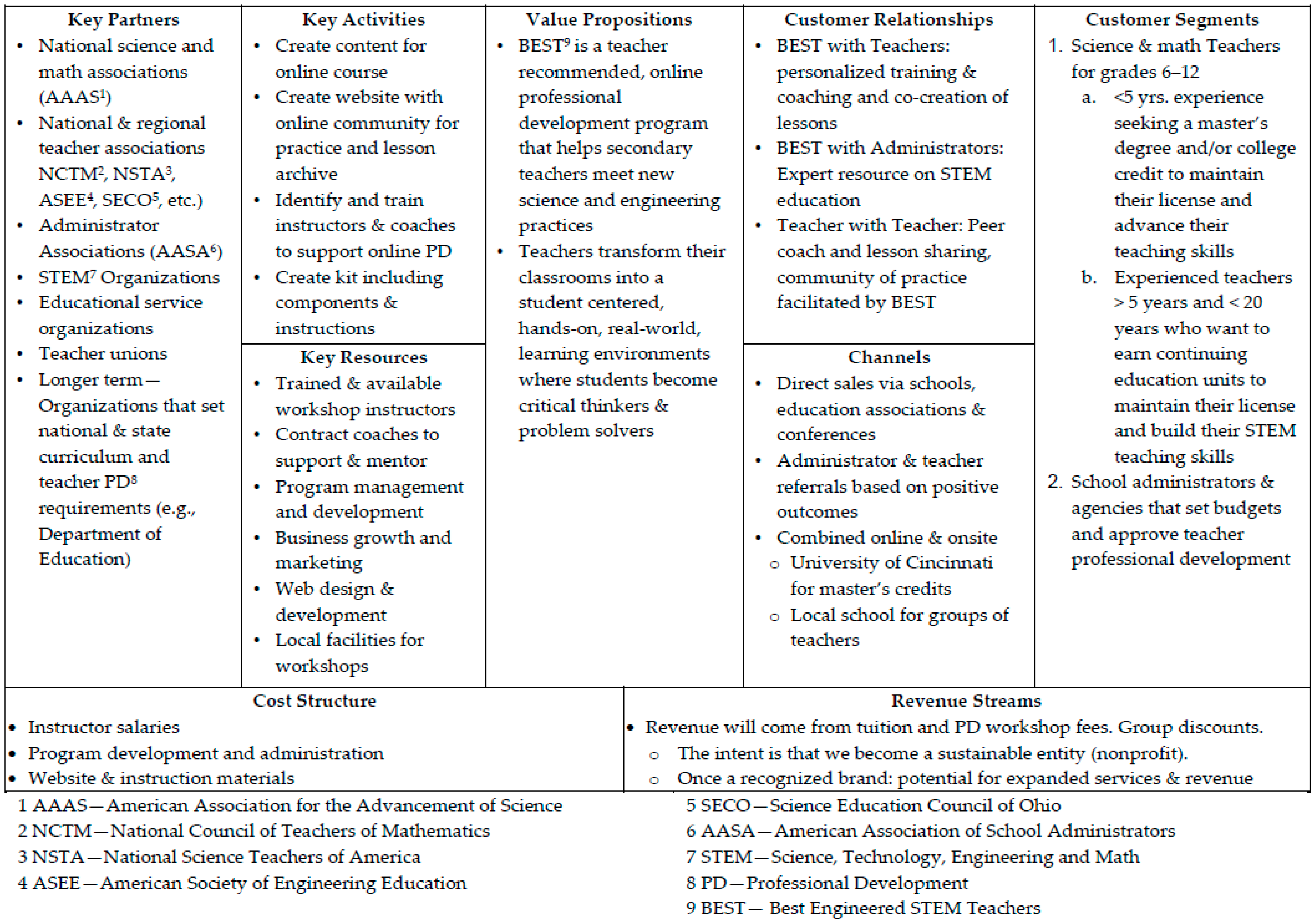
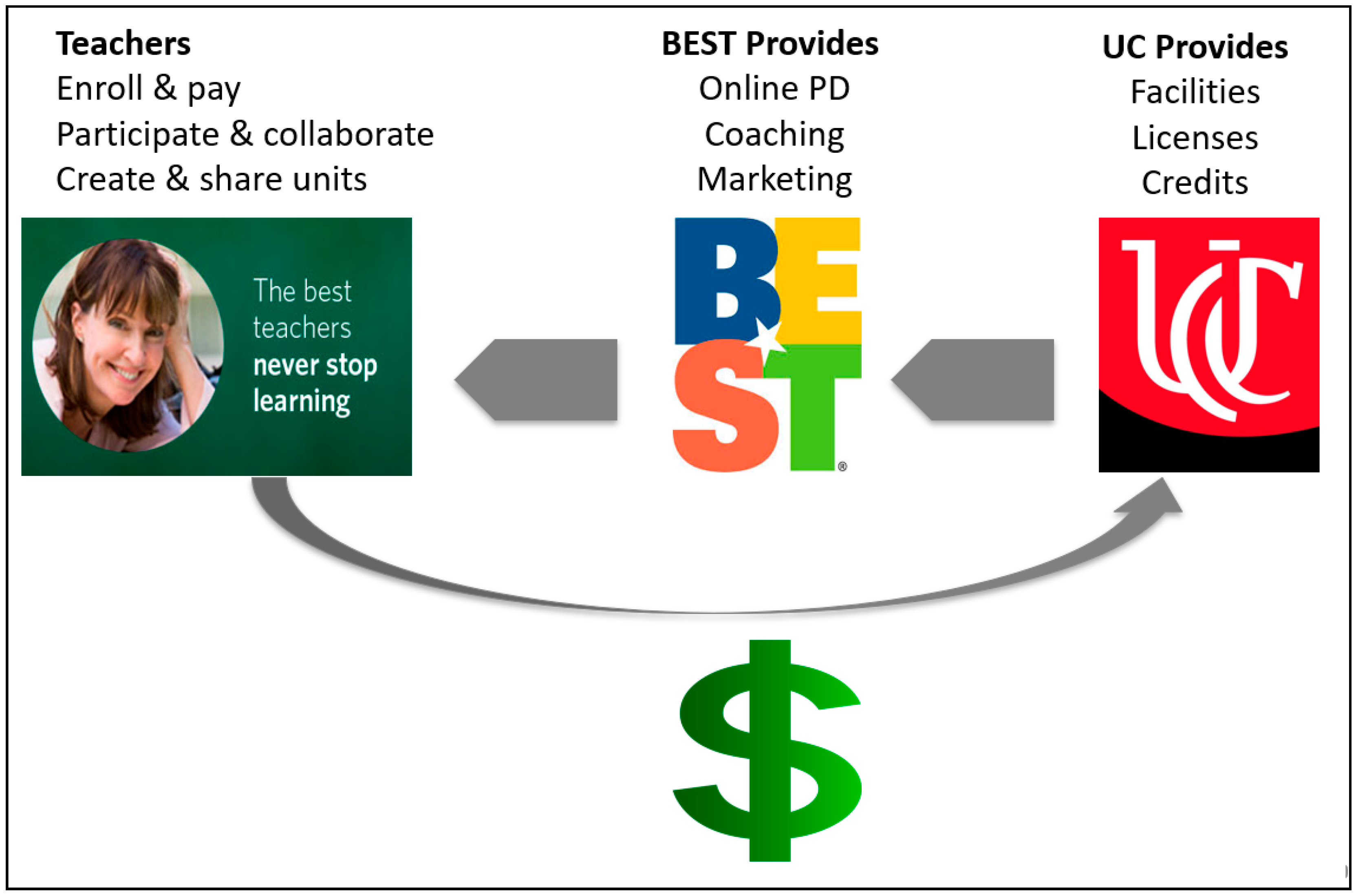
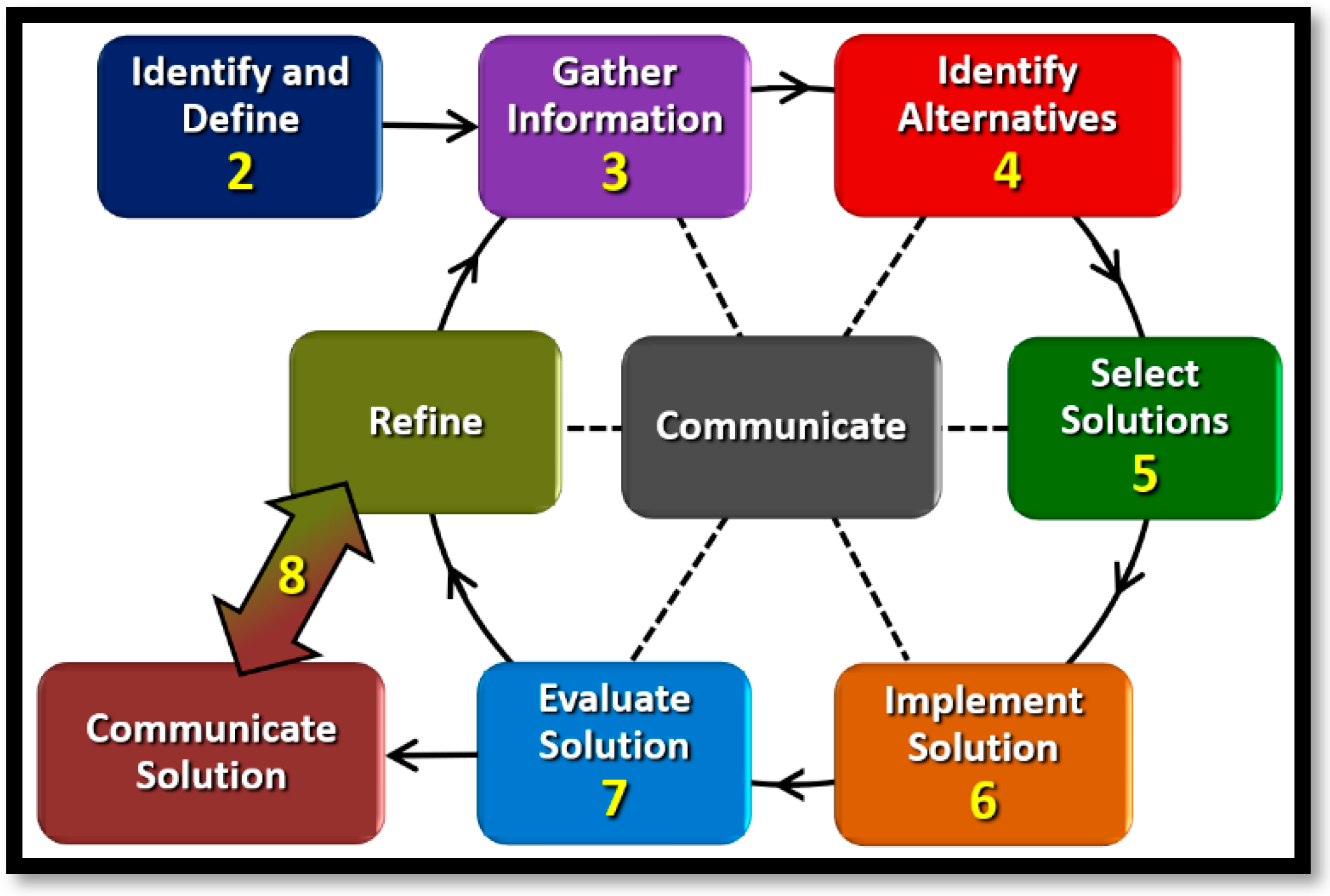
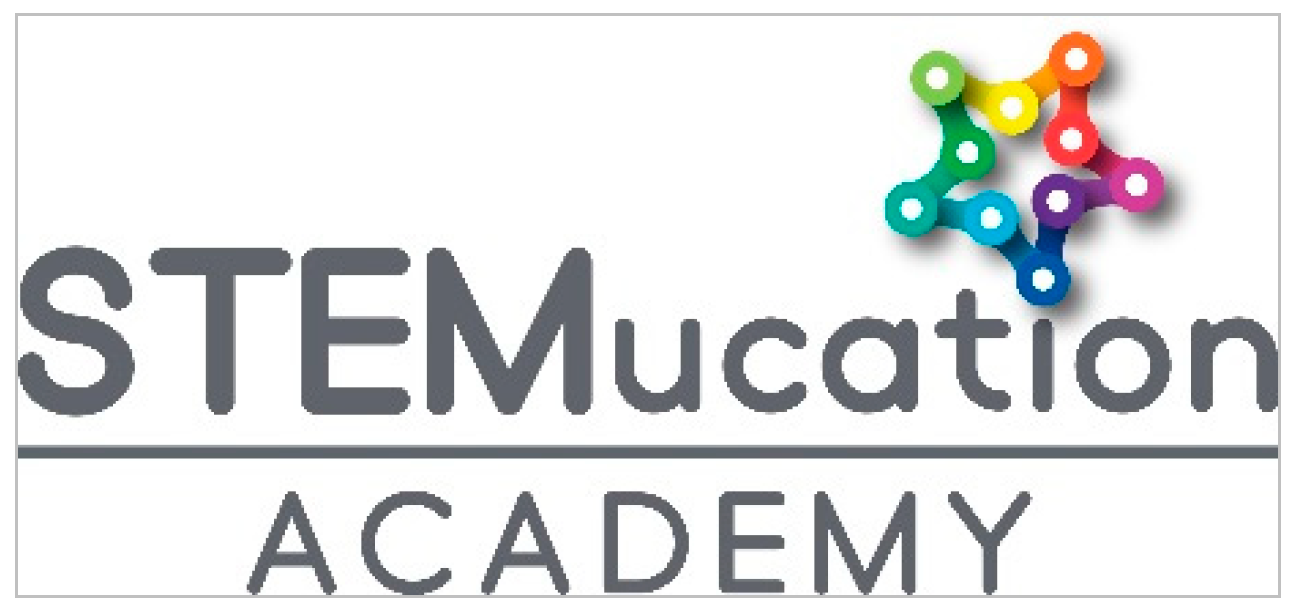
| Building Block | Description |
|---|---|
| Customer Segments | An organization serves one or several customer segments |
| Value Propositions | The business model seeks to solve customer problems and satisfy customer needs with value propositions |
| Channels | Value propositions are delivered through communication, distribution, and sales channels |
| Customer Relationships | Customer relationships are established and maintained with each customer segment |
| Revenue Streams | Revenue streams result from value propositions successfully offered to customers |
| Key Resources | Key resources are the assets required to offer and deliver the previously described elements |
| Key Activities | Key resources achieve their goals by performing a number of key activities |
| Key Partnerships | Some activities are outsourced and some resources are acquired outside the enterprise |
| Cost Structure | The business model elements result in the cost structure |
| Key Resource | How Key Resource was Addressed | Relative Cost |
|---|---|---|
| Entrepreneur Training | I-Corp L seven-week training program | None (Funded by grant) |
| A conference room for team meetings | Used conference room at University of Cincinnati where 2 of our team members were employed | None |
| A Learning Management System (LMS) for workshop course administration | Used BlackBoard and CourseSites for initial pilots. Google Drive tools also used as an alternative. | None |
| Instructional designer to develop the course outline and manage the LMS | Designer hired and expenses shared with another department | High |
| Course Developer | Course materials created by Team Members | Medium |
| Workshop Coaches | Identified a list of CEEMS teachers and Resource Team Members as potential coaches for workshop participants | Low to Medium |
| Web Site Developer | Outsourced to Northern Kentucky University | Medium |
| Branding and Brochures | STEMucation Academy branding and brochures created images. | Low |
| Intellectual Property Protection | Materials copyrighted | None |
| Workshop Materials | Conference workshops required materials for Engineering Design Process activities | Low |
| Conference Registration Fees | Paid through existing grants | Low |
| Startup Funding for aforementioned items | Available from existing grants | High |
| BEST Differentiators | ||||||
|---|---|---|---|---|---|---|
| Type | Examples | Description | Engineering Practices | Student Centered | Ongoing Coaching | Δ Teacher Practice |
| Online Content | Khan Academy MOOCs 1 | Online STEM 5 resources & classroom ideas | ||||
| National Science Organizations | AAAS 2 Project 2061 | Science curriculum & instruction | ||||
| NSTA 3 | Workshops/Online Science Matters | ✔ | ||||
| ASEE 4 | STEM Conference associated | ✔ | ||||
| National STEM Program | Engineering Is Elementary | Content & application lessons | ✔ | |||
| Project Lead the Way | Blended STEM professional development that links activities to engineering | ✔ | ✔ Problem-based learning only | ✔ Not longitudinal | ✔ | |
| BEST | Online & Face-to-face Workshops | Science & Engineering Practices and Student Driven | ✔ | ✔ | ✔ | ✔ |
| 1 A MOOC is a course of study made available over the Internet without charge to a very large number of people 2 American Association for the Advancement of Science | 3 National Science Teachers Association 4 American Society of Engineering Education 5 Science, Technology, Engineering and Math | |||||
| Unit Name | Grade and Subject | Hyperlink |
|---|---|---|
| Aiken’s Angry Birds | High School Physical Science | http://stemucationacademy.com/aiken-angry-birds/ |
| Designer Dogs | Grade 8 Science | http://stemucationacademy.com/designing-dogs/ |
| Feel The Noise | High School Pre-Calculus/Calculus | http://stemucationacademy.com/feel-the-noise/ |
| Trains Always Win | Grade 8 Algebra | http://stemucationacademy.com/trains-always-win/ |
| Rubric Element | Excellent (100–90%) | Acceptable (89–60%) | Unacceptable (59–0%) |
|---|---|---|---|
| Possible Essential Questions | At least 3 possible Essential Questions have been clearly written and are well related to the Big Idea for each if the identified challenges | 1 or 2 possible Essential Questions have been documented for each of the identified challenges | No possible Essential Questions have been documented |
| (15) | (15–13.5) | (13.5–9) | (8.85–0) |
© 2019 by the authors. Licensee MDPI, Basel, Switzerland. This article is an open access article distributed under the terms and conditions of the Creative Commons Attribution (CC BY) license (http://creativecommons.org/licenses/by/4.0/).
Share and Cite
Kukreti, A.R.; Broering, J. An Entrepreneurship Venture for Training K–12 Teachers to Use Engineering as a Context for Learning. Educ. Sci. 2019, 9, 54. https://doi.org/10.3390/educsci9010054
Kukreti AR, Broering J. An Entrepreneurship Venture for Training K–12 Teachers to Use Engineering as a Context for Learning. Education Sciences. 2019; 9(1):54. https://doi.org/10.3390/educsci9010054
Chicago/Turabian StyleKukreti, Anant R., and Jack Broering. 2019. "An Entrepreneurship Venture for Training K–12 Teachers to Use Engineering as a Context for Learning" Education Sciences 9, no. 1: 54. https://doi.org/10.3390/educsci9010054
APA StyleKukreti, A. R., & Broering, J. (2019). An Entrepreneurship Venture for Training K–12 Teachers to Use Engineering as a Context for Learning. Education Sciences, 9(1), 54. https://doi.org/10.3390/educsci9010054




